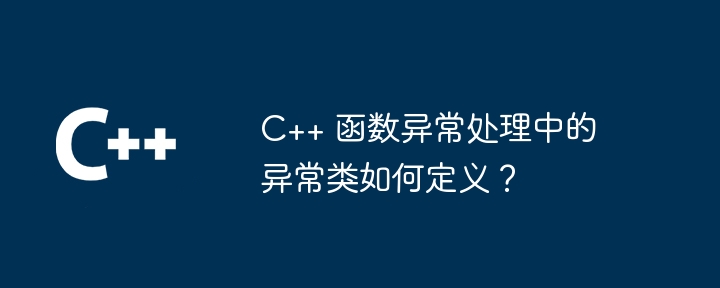
Exception class defined in C: A new class needs to be derived from std::exception and override the what virtual function to provide exception messages; as shown in the example, the MyException class overrides what to return exception messages. In the actual case, the divide function throws a std::runtime_error exception, and the main function captures and prints the exception message.

In C, the exception class is used to handle function exceptions. To define an exception class, derive a new class from the std::exception class and override the what virtual function to provide the exception message.
The following is an example of defining an exception class:
#include <exception>
class MyException : public std::exception {
public:
MyException(const char* message) : std::exception(message) {}
MyException(const std::string& message) : std::exception(message.c_str()) {}
const char* what() const noexcept override { return message_.c_str(); }
private:
std::string message_;
};In this example, the MyException class derives from the std::exception class, and Rewritten the what function to return an exception message. The message can be set in the constructor.
The following is an example of a function that uses the exception class:
#include <exception>
#include <iostream>
void divide(int numerator, int denominator) {
if (denominator == 0) {
throw std::runtime_error("Cannot divide by zero");
}
std::cout << "Result: " << numerator / denominator << std::endl;
}
int main() {
try {
divide(10, 0); // 抛出异常
} catch (const std::exception& e) { // 捕获异常
std::cerr << "Error: " << e.what() << std::endl;
}
return 0;
}In the above example, the divide function operates when the divisor is zero. Throws a std::runtime_error exception. The main function uses the try-catch block to catch exceptions and print the exception message.
The above is the detailed content of How to define the exception class in C++ function exception handling?. For more information, please follow other related articles on the PHP Chinese website!
 What are the differences between c++ and c language
What are the differences between c++ and c language
 Recommended learning order for c++ and python
Recommended learning order for c++ and python
 Cost-effectiveness analysis of learning python and c++
Cost-effectiveness analysis of learning python and c++
 Is c language the same as c++?
Is c language the same as c++?
 Which is better to learn first, c language or c++?
Which is better to learn first, c language or c++?
 The difference and connection between c language and c++
The difference and connection between c language and c++
 C++ software Chinese change tutorial
C++ software Chinese change tutorial
 Cost-effectiveness analysis of learning python, java and c++
Cost-effectiveness analysis of learning python, java and c++




